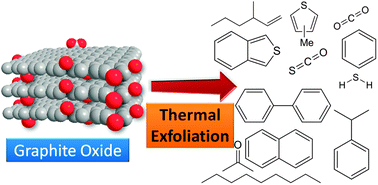Thermal exfoliation and deoxygenation of graphite oxide is one of the major routes for the preparation of large quantities of graphene-based materials. It is commonly believed that thermal exfoliation leads to the release of H2O, CO and CO2 gases. Here we show for the first time that in addition to these small simple molecules, there is a wide variety of complex organic molecules that are released from graphite oxide during the exfoliation process, such as alkanes, substituted polycyclic aromatic hydrocarbons and heterocyclic molecules. The compositions of the released volatile compounds depend on the exfoliation atmosphere (Ar, H2), pressure and the preparation methods of graphite oxide (such as Hofmann, Staudenmaier or Hummers). The structures of the decomposition products reflect the characters of graphite oxide precursors and are also directly related to the defects in the graphene products. As such, these findings have profound influences on our understanding on the structural defects of reduced graphenes, which consequently provide further insights into their properties.

